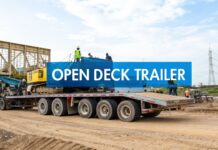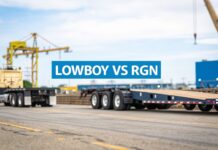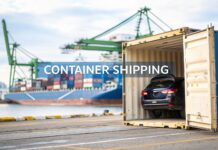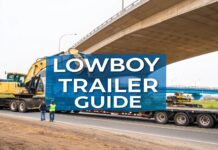When you need to move machinery that's too large, too heavy, or not street-legal—like bulldozers, cranes, or agricultural combines—you need specialized expertise. This is the role of heavy equipment hauling services. They provide the logistical solutions required to get crucial machinery for construction, farming, and industrial projects to its destination safely, legally, and on schedule.
Understanding the Hauling Process
Think of it as a moving service for industrial-scale assets. Instead of couches and boxes, haulers transport multi-ton machines that are the backbone of major industries. This process is more than just using a big truck; it's a discipline that involves meticulous planning, specialized trailers, and a deep understanding of complex transportation regulations.
Without professional heavy equipment hauling services, construction projects would stop, agricultural operations would be crippled, and energy infrastructure couldn't be maintained. These services are the essential logistical link that allows vital sectors to function by overcoming otherwise insurmountable transport challenges.
Actionable Insight: The Core Challenges in Heavy Hauling
Successfully transporting heavy equipment from point A to point B involves overcoming several critical hurdles. Understanding these challenges helps you appreciate the value a professional hauler brings to the table.
- Complex Route Planning: Every haul requires a pre-vetted route. Haulers must identify and avoid low bridges, roads with insufficient weight ratings, and local travel time restrictions. An actionable tip is to discuss the proposed route with your carrier to understand any potential delays.
- Permitting and Regulatory Compliance: Each state has its own rulebook for oversized and overweight loads. A professional service manages the entire permitting process, ensuring every leg of the journey is fully compliant.
- Secure Load Management: Securing a 40-ton excavator requires specialized chains, binders, and techniques to ensure zero movement during transit. Incorrect securement is a leading cause of transport accidents.
- Correct Trailer Selection: A reputable carrier will have a diverse fleet and the expertise to select the right trailer (e.g., flatbed, lowboy, RGN) based on your equipment's specific dimensions and weight.
The global market for heavy equipment transport was already valued at around $10 billion, and it's on track to hit $15 billion by 2033. This growth underscores the critical role of expert haulers who can manage these complex variables.
North America is a significant part of this market, accounting for approximately 35% of the industry's global revenue.
To gain a broader perspective, you can discover more insights about heavy equipment shipping statistics and see how the market is evolving. Now, let's dive into the practical aspects of cost, equipment, and regulations.
Breaking Down Heavy Equipment Hauling Costs

Determining the final price for heavy equipment hauling services involves several key variables. The cost isn't arbitrary; it’s a calculation based on critical factors that every professional carrier must assess to provide an accurate quote. Understanding these factors allows you to budget effectively and avoid unexpected costs.
Think of it this way: planning a road trip requires knowing the distance, the vehicle's fuel efficiency, and potential tolls. Hauling heavy machinery follows the same logic, but on a much larger scale. The two primary drivers of cost are the specifications of the equipment and the nature of the journey.
Core Cost Factors You Can Expect
Every quote is built on a foundation of basic information. To get an actionable quote, you must provide these details.
- Equipment Dimensions and Weight: This is the starting point. The length, width, height, and gross weight of your machine determine the type of trailer needed, fuel consumption estimates, and whether the load is classified as "oversized." Transporting a standard backhoe is fundamentally different from moving a large crane.
- Total Transport Distance: Unsurprisingly, the mileage from pickup to delivery is a major cost component. Longer distances mean more fuel, increased driver hours, and greater wear and tear on the transport vehicle.
- Route Complexity: A direct route on a major interstate will be more cost-effective than one involving winding rural roads, steep gradients, or dense urban areas. Difficult routes increase time, fuel usage, and require more driver skill.
Here’s the bottom line: total transparency is non-negotiable. You have to provide exact dimensions and weight to get an accurate quote. Being off by just a few inches or a couple hundred pounds can mean needing a different trailer or new permits, which leads to frustrating and expensive delays.
While these are the primary cost drivers, several other factors can influence the final bill.
The Additional Costs You Must Plan For
Beyond the basics of weight and distance, several other charges can pop up on your final invoice. These are sometimes called "soft costs" or "accessorial charges," and knowing about them ahead of time is key to keeping your budget on track.
The per-mile rate itself isn't set in stone. Industry data shows that heavy equipment hauling costs in the U.S. generally fall between $3 to $8 per mile. That said, on really long cross-country hauls over 2,500 miles, the rate can drop to as low as $1 per mile because of the efficiencies gained.
Geography plays a big part, too. You might see an average of $2.95 per mile for routes in the Western U.S., while the same kind of job in the Southeast could run closer to $3.76 per mile. If you want to dig deeper, you can learn more about heavy haul trucking trends and what to expect.
The cost-per-mile often gets cheaper the farther you go. Here’s a quick look at what you might expect:
Estimated Hauling Cost Per Mile by Distance
| Haul Distance | Average Cost Per Mile (Low End) | Average Cost Per Mile (High End) |
|---|---|---|
| Under 100 miles | $5.00 | $8.00 |
| 100 – 500 miles | $3.50 | $6.50 |
| 500 – 1,000 miles | $2.75 | $4.50 |
| 1,000 – 2,500 miles | $2.00 | $3.75 |
| Over 2,500 miles | $1.00 | $2.50 |
As you can see, carriers can offer a much lower per-mile rate on longer hauls since the fixed costs of loading and permits are spread out over more miles.
On top of the mileage, be ready for these potential costs:
- Permits for Oversized Loads: If your machine is wider than the standard 8.5 feet or taller than 13.5 feet, it’s officially "oversized." That means you'll need special permits for every single state it passes through, and each state has its own fees and rules.
- Pilot or Escort Vehicles: The biggest loads legally require one or more escort cars to travel with them to keep everyone on the road safe. This is a separate service that bills by the mile and by the hour.
- Loading and Unloading Assistance: Do you need a crane or a heavy-duty forklift to get the machine on or off the trailer? That's another service and another line item on the bill.
- Insurance Coverage: A good carrier will have standard liability and cargo insurance baked into their price. But if you're moving a particularly valuable piece of equipment, you may want to purchase extra coverage for peace of mind.
Getting all this information together before you ask for a quote is the best way to help a carrier give you a precise, all-in number. That way, there are no bad surprises when the job is done.
Choosing the Right Trailer for Your Equipment
When you're talking heavy equipment hauling services, the trailer is every bit as important as the truck pulling it. Picking the wrong one is like showing up to move a grand piano with a Miata—it’s just not going to work, and it’s definitely not safe. The first step to any successful haul is matching your machine to the right kind of trailer.
This isn't a one-size-fits-all game. Every trailer out there is a specialized tool, engineered for a specific job. The differences come down to things like deck height, how much weight it can handle, and how you even get the equipment on it in the first place. Getting this right is how you avoid headaches, extra costs, and potential damage down the road.
The Workhorses: Flatbed Trailers
The flatbed is the most common type of open-deck trailer. It's the versatile choice for many loads due to its simple, open design, which allows for loading and unloading from any angle with a crane or forklift. Ramps can also be used for drive-on equipment.
However, a standard flatbed's deck height of about 60 inches creates a height limitation. This makes them ideal for building materials or shorter, durable machinery, but loading a tall excavator could immediately put you in violation of legal height limits.
Lowboys and Double Drop Trailers for Taller Loads
For equipment that exceeds the height capacity of a flatbed, the lowboy trailer is the solution. A lowboy's key feature is its "well," a deck section that drops to sit just 18 to 24 inches off the ground. This design is crucial for hauling tall equipment, providing the necessary clearance to safely pass under bridges and overpasses.
This is the go-to trailer for moving:
- Excavators and Bulldozers: They can be driven right into the well of the trailer.
- Large Agricultural Machinery: Think massive combines or tractors that need that extra vertical clearance.
- Industrial Components: Tall factory parts or tanks that would be impossible to move otherwise.

As you can see, even a medium-sized bulldozer can push the limits of what a standard trailer can handle. That’s exactly why specialized heavy-haul solutions are so critical for getting the job done right.
The Ultimate in Loading: RGN Trailers
For the heaviest and most challenging loads, the Removable Gooseneck (RGN) trailer is the top-tier solution. Its defining feature is a front section (the gooseneck) that detaches, allowing the trailer's main deck to become a ground-level ramp. This provides unparalleled safety and efficiency for loading drivable machinery.
With an RGN, equipment like pavers, scrapers, and large forklifts can be driven directly onto the deck, eliminating the need for cranes or risky ramp setups. This saves significant time and reduces loading/unloading costs.
RGNs are built for extreme loads and can be configured with multiple axles to handle weights exceeding 150,000 pounds. For a deeper dive, you can explore our comprehensive guide to RGN trailer transport.
To give you an idea of how specialized this industry is, look at the dump truck market. Articulated dump trucks alone made up over 40% of the market's revenue in a recent year because they're so versatile off-road.
Let's break down the most common trailers you'll encounter.
Common Heavy Haul Trailer Types and Their Uses
Each trailer type is designed with a specific purpose in mind. Here’s a quick-glance table to help you understand which trailer is best suited for different kinds of equipment.
| Trailer Type | Common Use Case | Key Feature |
|---|---|---|
| Flatbed | Versatile loads, construction materials, smaller vehicles | Open deck for easy loading from all sides |
| Step-Deck | Taller cargo that needs more clearance than a flatbed | Two deck levels to accommodate height |
| Lowboy/Double Drop | Very tall or oversized equipment like excavators, combines | Deck drops very low to the ground for maximum height clearance |
| RGN | Heavy, self-propelled machinery (pavers, scrapers) | Gooseneck detaches to create a drive-on ramp |
Understanding these basic differences is the first step toward a smooth and successful transport project.
Ultimately, picking the right trailer isn't just a minor detail—it's a critical decision that affects the safety, cost, and legality of your shipment. By knowing the difference between a flatbed, a lowboy, and an RGN, you're better equipped to talk to your hauling provider and make sure your valuable machinery gets the expert handling it deserves.
Navigating Permits and Hauling Regulations
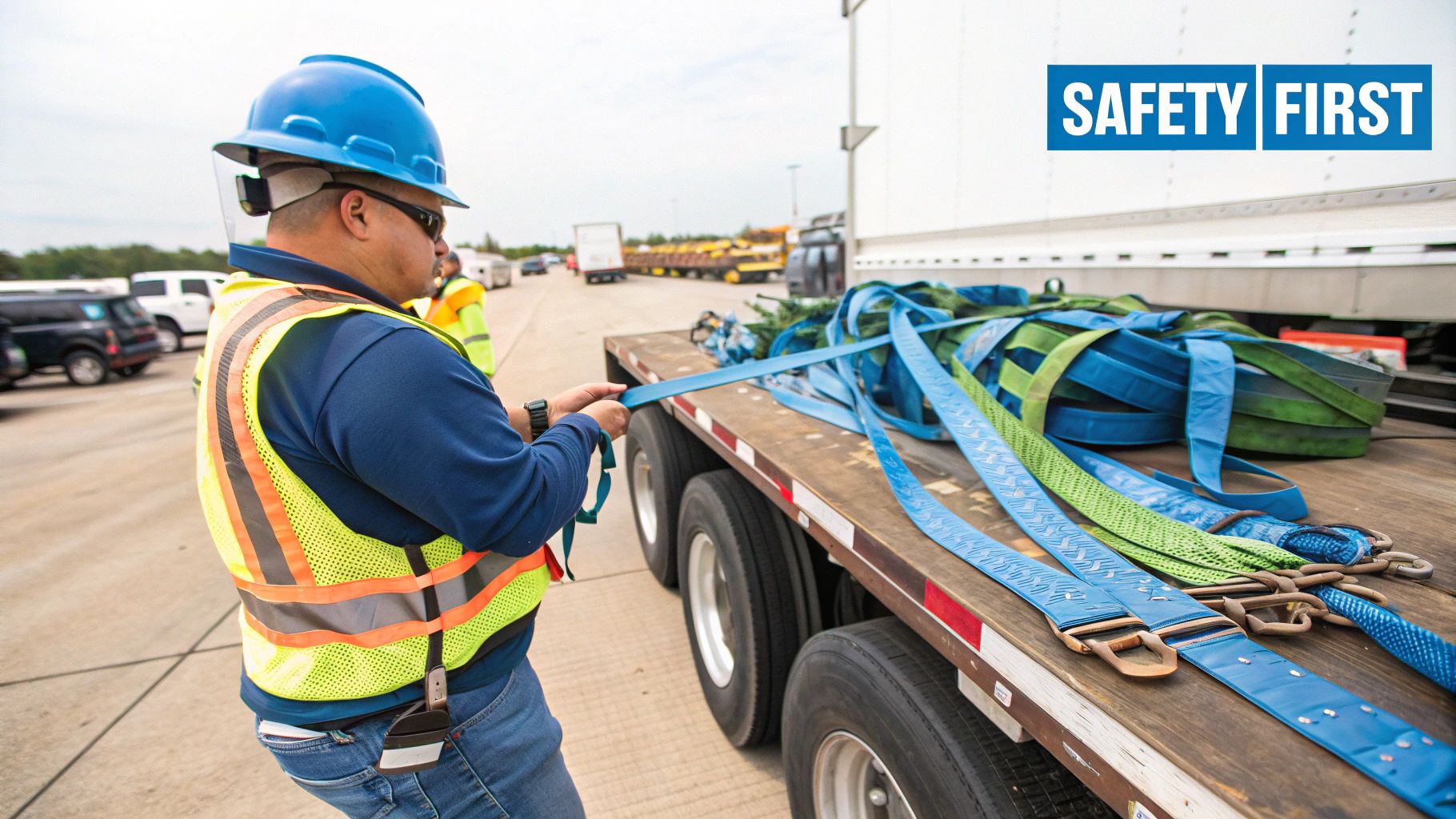
Transporting heavy equipment is a legally intensive process. The heavy equipment hauling services industry operates within a complex framework of federal, state, and local regulations. Ignoring these rules is not an option—it leads directly to severe fines, project-halting delays, and significant safety risks.
Think of it like international travel: you cannot simply show up at a border and expect to cross. You need a passport and the correct visas, all approved in advance. For heavy equipment, permits are the non-negotiable passport for the road.
The Foundation: Overweight and Oversize Permits
The cornerstone of hauling regulations is oversize and overweight permits. In the United States, federal guidelines establish the standard legal limits for a commercial truckload at an 80,000-pound gross vehicle weight, 8.5 feet in width, and 13.5 feet in height.
If your equipment on its trailer exceeds any of these dimensions, it is legally classified as an oversize or overweight load.
This classification automatically triggers the need for special permits. However, there is no single national permit. Each state the shipment passes through requires its own permit, with its own unique application process, fees, and rules. A cross-country haul might require navigating the regulations of a dozen different states.
For instance, one state may restrict travel to daylight hours, while a neighboring state might prohibit movement during rush hour. Professional haulers are experts in managing this regulatory patchwork, ensuring full compliance for every mile of the journey. If you're dealing with a particularly large machine, it's worth learning more about the specifics of https://www.wewilltransportit.com/services/hauling-oversize-loads/.
Beyond the Permit: Other Critical Rules of the Road
The permit itself is just the beginning. It's a conditional approval that comes with a set of rules that must be followed precisely to ensure the safety of the driver, the public, and the cargo.
Common permit requirements include:
- Pilot or Escort Vehicles: For larger loads, one or more escort vehicles are legally required to travel ahead of and/or behind the truck to manage traffic and provide warnings.
- Mandated Travel Times: Many permits specify the exact days and hours the load can be on the road, often prohibiting travel at night, on weekends, and on holidays.
- Pre-Approved Routes: The state provides a specific, mandatory route that has been verified to handle the load's weight and dimensions, avoiding weak bridges or low overpasses.
- Safety Signage and Lighting: Oversize loads must be clearly marked with signs, flags, and flashing lights to ensure high visibility to other drivers.
This whole web of rules highlights a crucial concept in the logistics world. As you get into the nitty-gritty of permits, it's vital to understand the Transport Chain of Responsibility, which spells out the legal duties for everyone involved in making the shipment happen.
Why You Need a Pro to Handle This
The sheer complexity of permitting is one of the biggest reasons to partner with an experienced heavy hauling company. It's not a side-gig for them; they have entire teams dedicated to this administrative marathon. They know the systems, have the contacts, and possess the expertise to get all the right permits, map out compliant routes, and line up any necessary escorts.
Trying to manage all this on your own without experience is asking for trouble. One tiny mistake on an application or a wrong turn off a mandated route can bring your entire operation to a screeching halt. Your valuable equipment gets stranded, and your budget gets blown to bits. Handing this off to the pros is the best way to guarantee a smooth, legal, and timely transport from start to finish.
Getting Your Equipment Ready for the Road
Proper preparation of your equipment is a crucial step to prevent damage, avoid delays, and ensure a smooth handover. Taking these actionable steps before your heavy equipment hauling services provider arrives protects your investment and streamlines the entire process.
Consider it like preparing your car for a long-distance trip. You wouldn't start with loose items inside, a dirty windshield, and no knowledge of your fluid levels. The same principles apply to heavy equipment, where minor oversights can lead to major problems.
Start with a Good Wash
Before transport, the machine must be thoroughly cleaned. This is not for aesthetics; it is a critical step for inspection and regulatory compliance.
A clean machine allows the carrier to conduct an accurate pre-trip inspection and document its condition on the Bill of Lading, noting any existing scratches, dents, or damage. Furthermore, many states have regulations against transporting foreign soil, seeds, or potential pests across their borders. Arriving at a DOT inspection with a mud-caked machine can result in fines or quarantine. A clean machine is a compliant one.
Lock Down All Loose Parts and Attachments
Highway travel involves constant vibration and movement. Any component that is not securely fastened is at risk of shifting, falling off, or being damaged.
Perform a detailed walk-around of your equipment before pickup and secure all loose parts:
- Attachments: It's best to remove smaller attachments like buckets, blades, or forks and secure them separately. If they have to travel with the main unit, make sure they are lowered, locked, and chained down on their own.
- Doors and Panels: Latch and lock every single cab door, window, and access panel. If a lock is broken, don't just leave it—use heavy-duty zip ties or wire to make sure it stays shut.
- Exhaust Stacks: Slap a waterproof tarp or cap over the exhaust stack. The last thing you want is rain getting into the engine while it's on the road.
- Movable Parts: Booms, arms, and anything else that articulates needs to be secured in its designated transport position. Check the manufacturer's guide if you're not sure what that is.
The goal here is simple: turn everything into one solid, unmovable unit. Every loose component is a potential hazard, not just to your equipment but to every other driver on the road. A loose part becoming a projectile is a carrier’s worst nightmare.
Check Fluids and Disconnect the Power
Managing fluids is crucial for both safety and weight management. Full tanks add significant, unnecessary weight and pose a spill risk.
Drain flammable fluids like fuel down to less than a quarter tank. Conversely, ensure essential fluids like engine oil and hydraulic fluid are at proper operating levels to allow for safe loading and unloading. As a final, critical step, disconnect the battery and secure the cables to prevent any possibility of an accidental startup or electrical short during transit.
Take Pictures of Everything
This is your most important pre-shipment task. Use your smartphone to take detailed, time-stamped photos of the machine from every angle. Document its condition meticulously, capturing close-ups of any pre-existing scratches, dents, or wear.
This photo gallery serves as your definitive proof of the equipment's condition before it was handed over to the carrier. In the unfortunate event of damage during transit, these images are indispensable for filing a successful insurance claim. It eliminates disputes and protects both you and the hauling company. A few minutes spent on this step can save you thousands of dollars.
Selecting a Reputable Heavy Hauling Company
Choosing the right transport partner is the most critical decision in the heavy hauling process. The provider you select directly impacts the safety of your equipment, the reliability of the delivery schedule, and your overall experience.
A professional company ensures a seamless process, while an unreliable one can lead to costly delays, equipment damage, and significant stress. You are entrusting an asset that could be worth hundreds of thousands of dollars, so a thorough vetting process is not just recommended—it's essential. Look beyond marketing claims to find a carrier with a proven record of safety, reliability, and professionalism.
Verifying Credentials and Insurance
Before discussing pricing, verify the carrier's foundational credentials. These are the non-negotiable qualifications that distinguish professional operators from high-risk alternatives. A reputable company will provide this information readily.
First, request their MC (Motor Carrier) and DOT (Department of Transportation) numbers. You can use these identifiers to check the company's operating status, safety record, and inspection history on the Federal Motor Carrier Safety Administration (FMCSA) online portal.
Next, you must confirm their insurance coverage. Do not just accept their word; ask for a current certificate of insurance.
- Cargo Insurance: This policy covers your equipment during transit. Ensure the coverage limit is sufficient to protect the full replacement value of your machine.
- Liability Insurance: This covers damage to property or injury to people during transport. A minimum of $1 million is the industry standard.
A carrier who gets cagey about showing you proof of insurance or whose coverage seems flimsy is a massive red flag. Proper insurance is the foundation of any secure and professional hauling operation.
Key Questions to Ask Potential Carriers
Once credentials are verified, ask targeted questions to gauge their experience and operational standards. Their answers will reveal their level of expertise.
A great place to start is asking about their experience with your exact type of equipment. Have they moved a similar bulldozer or excavator before? A company that knows your kind of machinery will already understand its unique tie-down points, transport challenges, and how to load it correctly. For a better idea of what specialized transport looks like, you can find out more about our heavy equipment transport services and see how much experience really matters.
You should also ask them about their safety record. Ask for their CSA (Compliance, Safety, Accountability) score, which gives you a quick snapshot of their safety performance. A lower score is what you want to see, as it means fewer violations and accidents.
Spotting Red Flags and Securing a Contract
During your evaluation, certain warning signs should prompt caution. An unusually low price is often the most tempting but dangerous red flag. If one quote is significantly lower than others, it may indicate that the carrier is cutting corners on insurance, permits, or equipment maintenance.
Also, be wary of any company that demands the full payment upfront or tries to pressure you into a fast decision. A professional carrier will provide a detailed, written contract and give you plenty of time to look it over.
This final contract is your ultimate safety net. It should clearly spell out:
- Scope of Services: The exact pickup and delivery locations and dates.
- Total Cost: A complete breakdown of all charges, including fuel, permits, and any other potential fees.
- Insurance Details: Confirmation of the cargo and liability coverage for your specific haul.
- Responsibilities: A clear statement on who is responsible for loading, unloading, and getting the permits.
Never, ever move forward with a haul based on just a verbal agreement. A detailed, signed contract ensures everyone is on the same page and gives you legal protection if anything goes wrong. By following this simple framework, you can confidently pick a reliable partner to get your equipment moved safely and professionally.
Got Questions? Here Are Some Quick Answers
Even with the best-laid plans, a few questions always seem to pop up when you're setting up a heavy equipment haul. We get it. That's why we've put together some straightforward answers to the questions we hear most often. Think of this as your final sanity check before you give the green light.
These quick answers will clear up any confusion about timing, costs, and what's expected of you, so you can lock in your transport plans with total confidence.
How Far in Advance Should I Book the Haul?
The sweet spot? Aim to schedule your heavy equipment transport at least one to two weeks ahead of time. This isn't just about finding a truck; it gives the carrier the breathing room they need to nail down all the complex logistics.
This lead time is absolutely critical for a few key things:
- Getting the Right Permits: If your machine is oversized or overweight, securing the necessary permits can take several days. This gets even more complicated if you're crossing state lines, as each one has its own set of rules.
- Planning a Safe Route: The carrier has to map out a DOT-approved path that steers clear of low bridges, road work, and weight-restricted roads. This takes time and careful planning.
- Lining Up Escorts: If your load requires pilot cars, those drivers and vehicles need to be scheduled and coordinated well in advance.
Sure, some carriers might be able to handle a last-minute request, but you'll almost always get a better price and a smoother ride with more notice. Trying to rush it is a surefire way to drive up costs and risk delays.
And don't forget, things like bad weather, holidays, and even high demand in a certain region can throw a wrench in carrier availability. Planning ahead is truly the best way to lock in a solid schedule that works for your project.
What Info Do I Need to Get an Accurate Quote?
If you want a fast, reliable quote, you need to come prepared with the right details. Vague information just leads to ballpark estimates and potential headaches on pickup day.
Be ready to share these key pieces of info with any carrier you talk to:
- Exact Dimensions: The machine's length, width, and height. Don't eyeball it—pull the numbers from the manufacturer's spec sheet.
- Operating Weight: This is one of the biggest factors driving the cost, so you need the precise weight.
- Make and Model: This tells the carrier everything they need to know about the machine's specific quirks and transport requirements.
- Pickup and Delivery Addresses: Full addresses, zip codes included, are a must for calculating mileage and mapping the route correctly.
- A Few Good Photos: Snapping a couple of clear pictures helps the carrier confirm the machine's condition and spot any unique attachments or features.
Giving them all this information right from the start means they can give you a solid, all-inclusive quote. It’s the best way to avoid any surprise charges down the road.
When you're ready to move your valuable machinery, you need experts who treat every detail with the precision and care it deserves. For reliable, professional heavy equipment transport, get in touch with We Will Transport It and get your free, no-obligation quote today. Find out more at https://www.wewilltransportit.com.

